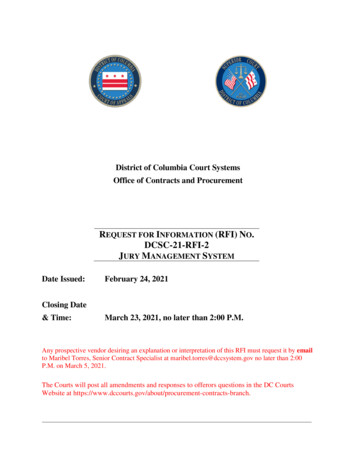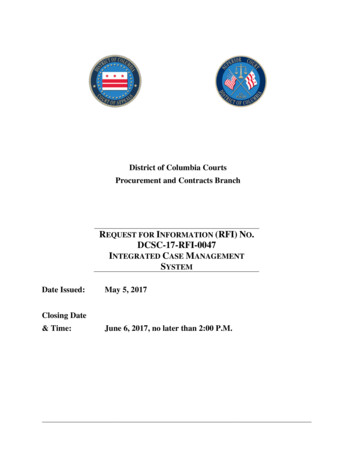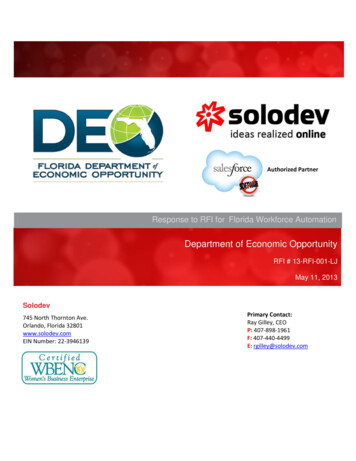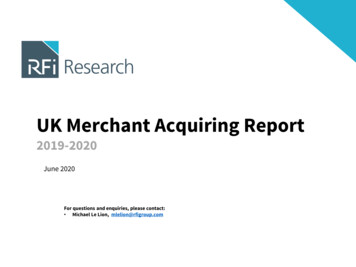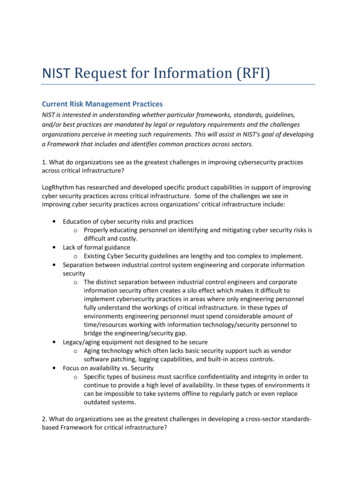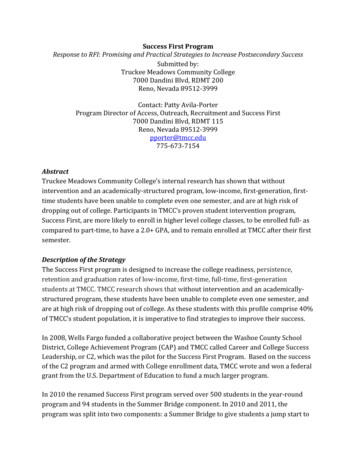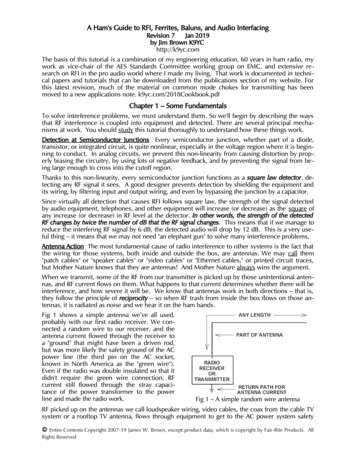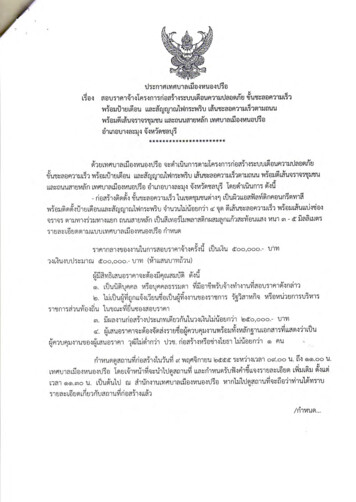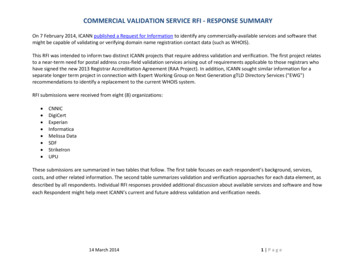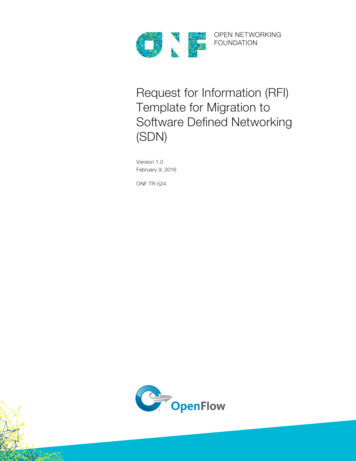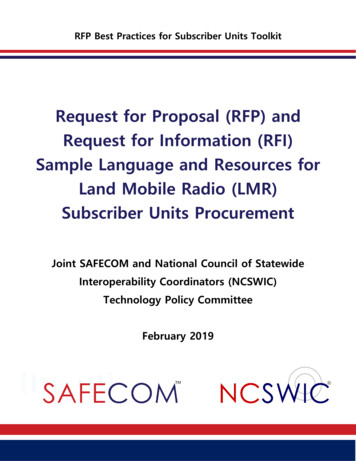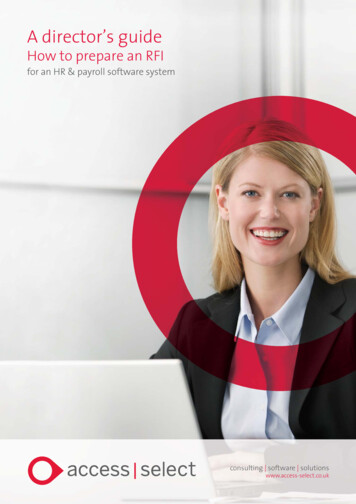
Transcription
A director’s guideHow to prepare an RFIfor an HR & payroll software systemconsulting software solutionswww.access-select.co.uk
Selecting a new HR & payroll system isa big decision, one requiringsignificant investment of time andcapital. You want to ensure that youchoose the right system from themost experienced vendor at the bestprice.Given the average term for a softwaresystem is 7–10 years, this is a longterm commitment so you need to getit right. Costly mistakes can howeverbe avoided by running an effectiveselection process. As with anysuccessful project, preparation is key –and should begin with the process ofdocumenting your needs.Based on your specific needs you haveidentified a list of potential suppliers,and you now need to document yourrequirements for the project in theform of an RFI.As part of the RFI creation you will needto consider the selection timeline andby having a strict timetable, will makesure that you (not the vendors) are incontrol of the process.Any RFI should include specific dates for: confirmation that the vendor willbe responding submission of questions by vendors completion of responsesThere are several terms to describethis process. You may be familiar withRequest for Information (RFI), Invite toTender (ITT) or Request for Proposal(RFP). For consistency, we’ll refer to theterm RFI throughout this guide. By theend, you’ll understand exactly how theprocess works, what a good RFI shouldcover, and how you can avoid the mostcommon pitfalls.To help you get started, we’ve alsoproduced an RFI template. Thisprovides the framework you need tostart completing your RFI. Details ofhow you can download thiscompliementary document areprovided at the end of this guide.What is an RFI?An RFI is the common way to collectdata on the capabilities of differingsoftware packages and vendors. It is aformal document, detailing yourspecific requirements, aimed to solicitresponses that allow direct comparisonbetween alternative solutions. The RFIwill often be the first point of contactwith a potential supplier, and it sets thetone of the relationship.How does the RFI processwork?Prior to reaching this stage, you willhave identified the need to change,agreed a business case, secured abudget and gained approval to moveto a vendor selection process. Clickhere to read our guide to the selectionand evaluation process.2 identification of shortlisted vendors formal demonstrations byshortlisted vendors selection of the successful vendor contract signing.The remainder of this guide will focuson the RFI document, but carefulconsideration of the selection processis required to ensure you are gearedup to manage the responses.The importance of scopingwithin the RFIIf you were buying a car, you wouldstart with a budget, which would steeryou towards a particular set ofmanufacturers. Then you would focuson the type of car, and then look atspecific features, compare the variousoptions, understand the delivery leadtimes, and then negotiate a price.Setting requirements for a new HR &payroll system should be no different.Here are the key reasons companies sooften get this wrong: the wrong people are involved inthe definition process. Directorsand senior managers can define thebusiness strategy that is driving thechange, but may not be able toarticulate the detailed functionalrequirements. End users may beable to help with the requirementsbut will be focused on their specificpart of the business, and not seethe end-to-end process.So select a project team whichencompasses both strategicknowledge and operational detail. difficulty nailing down the specificscope of the project. Scope creep isa classic problem in requirementsdefinition, where stakeholders getcarried away with the possibilitiesof a new HR & payroll system, andcontinue to add in new featureswhich may ultimately change theentire complexion of the project.Keep revisiting the original projectobjectives and don’t allow excessivescope creep in the RFI. trying to do too much with toolittle. If you are working to a tightbudget, you have to stick to a tightrequirement – don’t be tempted tosqueeze in too much. Somethingwill have to give, and this is usuallythe quality of the deliverable.Think about de-scoping to reducethe budget without constrainingthe solution; choosing a flexiblesystem will ensure you can easilyadd in further functionality whenbudgets allow. being too ambitious with timing.You may have a ‘burning bridge’ interms of a compelling event thatnecessitates change.It may be that you are already toolate based on the work required toeffect the change in time, butdon’t try and rush – either simplifyto deliver the bare minimumneeded now, or think aboutcontingencies and set a moresensible date.By keeping the RFI focused on theoriginal project objectives you canensure you don’t end up with a tractorwhen you wanted a family saloon.The RFI formatYour HR & payroll system RFI will beunique, based on the specificrequirements of your business, butthey should all contain the same basiccomponents. The following sectionsshould be considered for inclusion inyour RFI document. Access 2010. E&OE.
Company informationYou need to outline your business,the market in which it operates, yourproducts and services, and other keyfacts regarding the size and scope ofyour operation.This will provide a useful context forvendors, as well as a guide for theprovision of comparable reference inyour industry.Background & business objectivesThis should detail why your companywishes to implement a new HR &payroll system, or replace an existingsystem. This is not the place to list allthe shortcomings of your currentsoftware.This is about understanding the keydrivers for change – which could includereducing admin & increasing efficiency,improving staff engagement, reducingrecruitment and turnover costs ormeeting regulatory requirements. Thiswill help vendors to articulate how theirsolution will deliver on your strategicHR & payroll objectives.Project timescalesThis should include a summary of thekey milestones in the selectionprocess, including an expectation ofproject commencement and go-live.Ensure you include enough time forvendors to respond – a rusheddeadline will result in a poor quality ofresponse, and busy vendors will oftenreject RFIs with unrealistic deadlines.Make sure you give yourself plenty oftime to review responses, and makesure key stakeholders’ diaries areupdated with supplier visit days andRFI response reviews. As a guide, forany significant HR & payroll systemproject you will need a minimum sixmonth window between issuing theRFI and expected go-live.Format of responseYou need to indicate to the vendorshow you wish the RFI to be completed,including printed copies and electronicdocuments required, and anysupporting information. Insist thatresponses are delivered in your desiredformat, as any vendor specific responseswill make direct comparison difficult, Access 2010. E&OE.and will also make it difficult tounderstand the extent to which avendor has met your specificrequirements. We’ve provided atemplate to help you do just that –see ‘How to use the RFI template’ onp6 of this guide.Evaluation criteriaVendors need to understand howresponses will be evaluated; the cost ofthe new HR & payroll system shouldnot be the only determining factor.By sharing your priorities upfront,negotiations can be transparentwhile still getting the best deal foryour company. The final selectionmust be based on a balanced view ofcost, benefit, experience, servicestandards, functional, technical andcultural fit. You need to give a broadview of your priorities so that avendor can demonstrate their abilityto deliver on them.Confidentiality statementThis is to ensure that potentialvendor(s) keep your company and RFIdetails confidential. It is alsoimportant to stress that the answersprovided have contractualsignificance. If your RFI relates to aparticularly sensitive businesschange, or shares financial data, thenyou may insist on a Non-DisclosureAgreement (NDA) prior to issue of theRFI to the vendor.Vendor queriesExperienced vendors will seek to meetwith you prior to completion of theRFI, in order to clarify requirementsand gain further insight to yourcompany and needs. You maywelcome this as an opportunity togauge interest prior to receipt, and geta feeling for the culture of the vendor.You may also want to share theanswers to any vendor queries with allvendors, to ensure a consistentunderstanding of the requirement.Provide the vendors with someguidance as to the options available.Vendor informationIt is usual to request details on thevendor to understand their suitabilityand security as a partner for whatwill be a long-term relationship. Inaddition to financial informationsuch as recent turnover figures,you may also want to understand thecompany structure, number of offices,staff in each department and theproportion of the business dedicatedto the solution proposed.Some vendors will be happy to provideaudited accounts, for others you canrequest the registered company addressand the company registration number,and conduct your own credit checks aspart of the due diligence process.Business requirementsThis forms the core deliverable of theRFI, and will be the major focus forvendors. A statement of your businessrequirements should be provided as astructured checklist, indicating: functional requirements (e.g. abilityfor users to record an absencerequest and define a customworkflow for manager approval) technical requirements (e.g.solution must be based on aMicrosoft SQL-Server platform) integration requirements (e.g.solution must provide a real-timestock level integration with ourwarehouse management system).Vendors should be given the chance tostate the extent to which eachrequirement will be met based on thesolution proposed by the vendor, from‘standard’ through to ‘requiring bespokemodifications’ or ‘not achievable’.Special attention should be given tothose requirements which are unique toyou or your industry, or have proven tobe a challenge in your current solution.Integration with existing systemsshould also be carefully considered, asthis area is often overlooked.This section of the RFI is best deliveredby the vendor via a spreadsheet tosimplify the generation of a balancedscorecard. The following instructionstake you through this process. This isthe time to sit down and reallythink hard about your business and itsfuture. It is essential to be clear aboutwhat your needs are now and whatthey will be in a few years time.Once complete, the spreadsheetshould be sent to the vendor alongwith your RFI template (to downloadthe template, see p6 of this guide).3
Business requirementsVendor’s response benefits, pension, fleet management1.0RecruitmentThe ability to create a newemployee from candidateinformation as part of asuccessful recruitment processCAbility for staff to access lastpayslip through self-serviceportalC2.3Self-serviceNot achievableDescription of requirement organisation structureBespokeBusiness areaStd with configRefStandardCriticality C/P/O salary modelingRecruitment and selection vacancy creationNotes track applicants success, cost & equal opportunitymonitoring mail merge (post and email) transfer to payroll online recruitment3.74.1Learning &developmentInterfacesProvide training courseavailability to staff and bookingthrough self-service portal, withmanager approvalPThe solution must interface with Cour existing time and attendancesystemLearning and development training course administration online booking CPD and NVQs email / calendar integration5.2TechnicalrequirementsThe core system must operate on Ca Microsoft SQL-Server databaseplatformHow to create the ‘businessrequirements’ document: Create a spreadsheet based on thegrid above (note: the content withinthe chart is for example only). Fill out the second column with thekey operational areas within yourbusiness. We’ve included someexamples – you’ll find many moreunder the next heading. online appraisals (inc. competencymodels) skills search and managementNote: all critical requirements shouldbe met with a ‘standard’ / ‘standardwith configuration’ response.Self-serviceAny responses met with ‘bespoke’ or‘not achievable’ should be questionedfurther as part of the shortlistingprocess to understand the level ofchange required and potential risk tothe implementation. training request and authorisation holiday/planned absence requestand authorisation online appraisals sickness self-certification online forms e.g. return to workPayroll Complete the ‘description ofrequirement’ part of the grid for eachof your business areas – again, usingthe examples below as a guide.Finally, keep this spreadsheet handyuntil you are ready to send it(alongside your RFI document) to thevendor. Enter the ‘criticality’ for each row inyour chart. As a guide to responses:Examples of business areas part payment for starters & leaversAs a guide, other functional areas toconsider for a HR & payroll system RFImight include: payment/deduction formulaeC – critical, key to the delivery of theoverall solution links to accounts, BACS and time &attendance departmental & cost code reporting timesheet facilitiesP – preferable, whilst not critical,would be extremely beneficial tothe solutionHR administrationO – optional, an additionalrequirement that may or may notfeature in the final solution. job and salary historyWorkflow employment details holiday & training requests disciplinary and grievance request creation of a vacancy skills and competencies self certification absence and holidays new employee processes health & safety custom workflowsWe have included instructions withinthe RFI template (see p6) to helpvendors respond to your criticalityratings.4 online payslips personal details P11D production Access 2010. E&OE.
Managing information data migration document management user training approach business intelligence go-live. reporting KPI dashboards.Solution detailsVendors should provide an overview ofthe software, hardware andinfrastructure components utilised indelivering the proposed HR & payrollsolution. This should include productnames, specific modules utilised,integration, methods of user interface,(such as desktop PC, external webportal), reporting tools and referencesto any third-party products utilised.The RFI should state how thisinformation is to be provided by thevendors, and whether additionalinformation such as screen shots orstandard reports are needed.Vendor experienceIdeally vendors will have existingexperience implementing similarsolutions for companies in yourindustry. A minimum of three namedreference sites should be requested,indicating the similarities with yourorganisation and requirements,including specific software used oneach site. You should not expect to beable to speak to any reference sites aspart of the RFI process. You shouldhowever insist on a reference call or asite visit once a vendor has beenshortlisted.Implementation methodologyVendors should be asked to definetheir implementation methodology,and highlight how it will be used tominimise the risks involved withcomplex systems implementations.You may also request anyaccreditations that this methodologyhas received, or how the consultantsinvolved in the project are accreditedin the methodology.You should request specific details oncertain key elements which should becommon to any implementationmethodology: confirmation of detailedrequirements hardware and software installation software testing process & signoff Access 2010. E&OE.Project planA high level project plan should berequested, indicating expected tasksand timeframes for a project of thisnature. This should correspond to thepricing given, in terms of number ofman days to deliver services, as well asthe stages identified within theimplementation methodology. Theplan will be subject to validation bythe selected vendor, but should give agood indication of the effort requiredto complete.You may also request the amount oftime that you and the majorstakeholders will be expected tocommit to the project, including anyworkshops, testing, training and golive requirements.Go-live planning for the new HR &payroll system will also be key, ensurevendors identify the plan for cutover(usually after month end), finaltransfer of data etc. and that this fitswith your operational needs.Data migrationSpecial attention should be given tothe migration of legacy HR/payrolldata. The volume and type of historicdata required in the new system willhave an impact on costs andimplementation timescales. You willalso need to consider whatinformation will be retained in yourold HR/payroll system (or paperrecords) for future reference purposes.Where this is a new systemsimplementation, there may be asignificant amount of data entryrequired. Provide a high level view ofwhat data will be migrating across,from what systems, and ask vendors tobuild this into the implementation plan.Support requirementsYou need to understand the standardservice levels available to you forsupport of the system, includingdetails of where the support team isbased, whether it is outsourced to athird party, support response times,and what is included and excluded inthe support fee.You also need to understand theescalation process should a supportrequirement not be met,including the process to address anysoftware faults found in your livesystem. If you have special supportrequirements (e.g. outside of normalworking hours) you need to indicatethis to the vendor in the RFI.CostsYou need to split out different costtypes for comparability purposes. Askfor the costs to be presented in aspecific format, again forcomparability. You therefore need torequest the following: the type of cost quoted for theproject (e.g. fixed price, time &materials) upfront costs such as software anduser licenses, implementationservices, and consultant day rates transactional costs (for SaaS typearrangements) ongoing costs such as support,upgrade and general maintenance any additional costs such as projectmanagement, or projectcontingency timing of payments (payments atcontract signing, on installation, ongo-live etc.)User numbers will have an impact oncosts, so you will need to state thenumber of users by function / role: core HR users – generally workingin the HR function and using thesystem on a daily basis e.g. creatingnew employee records and settingup reporting hierarchy core payroll users – usually adedicated resource using thesystem daily e.g. checking/signingoff the payroll, ensuring monthlyprocedures are completedaccurately and on time managers – may need access to theHR system for the purposes ofapprovals and performancemanagement for their team employees – dependent on scope ofthe system, users may need toaccess the system through a portal,update contact details, accesspayslips, or enter absence requests.5
If finance is required to fund the project,you may want to request the fundingoptions available from the vendor.It should be stated that all costsrelating to the preparation,submission, and presentation of thesupplier’s response to this RFI shouldbe borne by the supplier.How to use the RFI templateWe’ve made an RFI template availableat www.theaccessgroup.com/RFI-HRcovering the most commonrequirements as detailed in this paper.We recommend the following steps incompletion of the RFI template: meet with the major stakeholdersto confirm the objective of theproject, the high level scope, keydates and the evaluation criteria tobe used meet with the functional owners todetail the functional requirements,user numbers, transactionalvolumes, data migrationrequirements and support needs meet with your IT department orprovider to document the technicaland interfacing requirements, andwhat IT support will available formigration, testing andimplementation develop a draft of both the RFI andbusiness requirements documentsfor interna
produced an RFI template. This provides the framework you need to start completing your RFI. Details of how you can download this compliementary document are provided at the end of this guide. What is an RFI? An RFI is the common way to collect data on the capabilities of differing software
